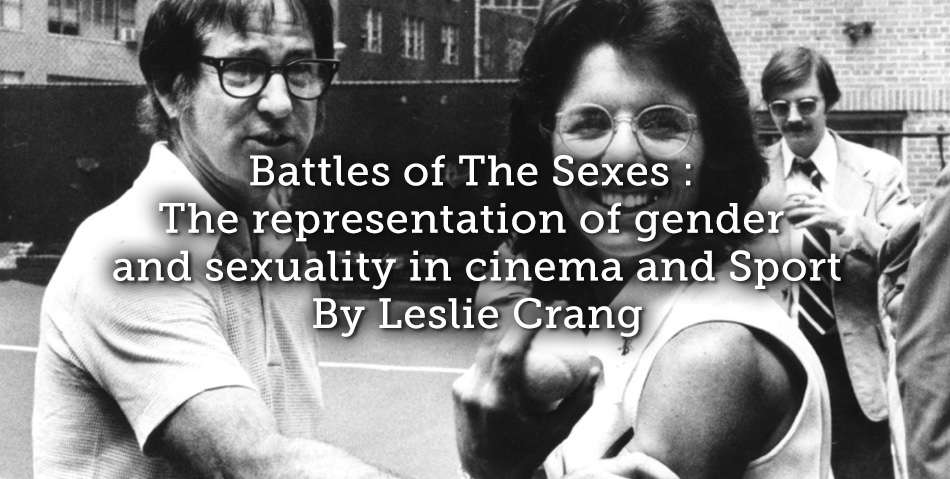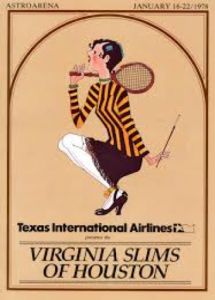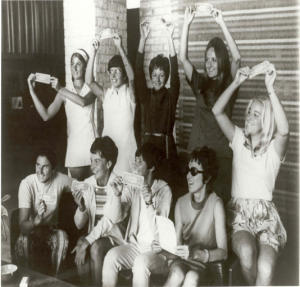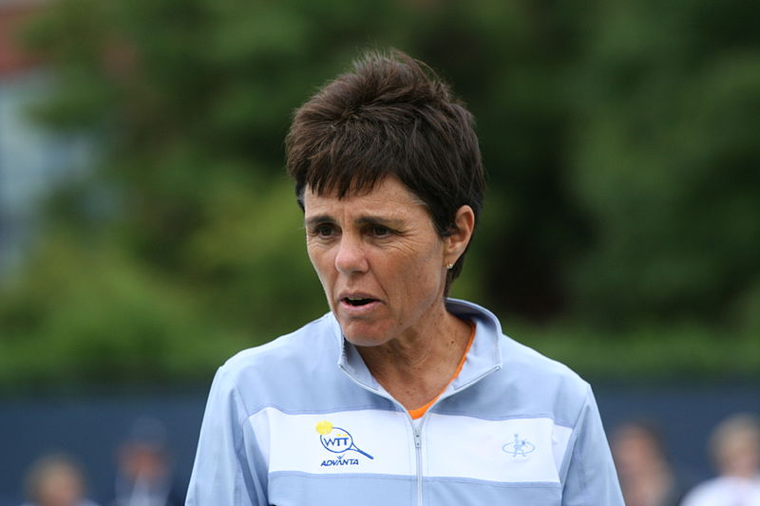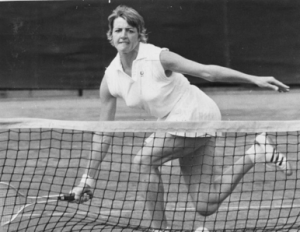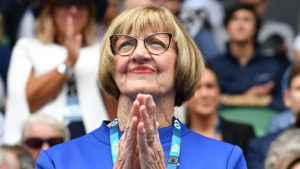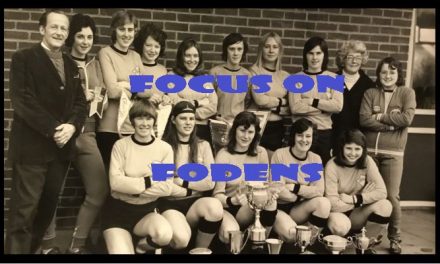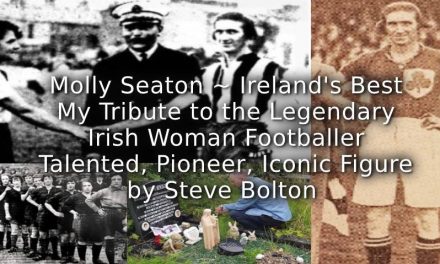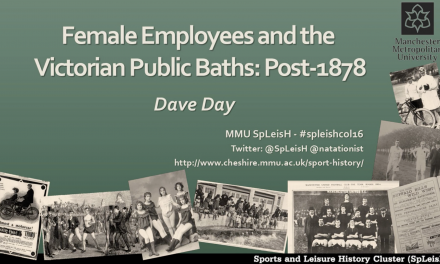You do not win by struggling to the top of a caste system, you win by refusing to be trapped within one at all.
Naomi Wolf, Beauty Myth
To become a cliche, one needs to quote one. Therefore, Tennis movies are becoming like London buses this year in that we have had two come along at once. In August came Borg Vs McEnroe, a biopic of the 1980 Wimbledon Final (something I wrote about recently here), then on 24th November, 2017, comes the UK release of Battles of The Sexes, a Hollywood production The true story of the 1973 tennis match between world number one Billie Jean King and ex-champ and serial hustler Bobby Riggs. Ironically, a documentary of the same title Battles of The Sexes was released in 2013, made by the Sporting documentary filmmaker James Erskine, whose other films include Building Jerusalem, which dealt with the 2003 Rugby World Cup final between England and Australia. He also adapted Peter Davies ‘All Played Out’ entitled One Night in Turin, which IMDB describes thus:-
Before the Premier League and multi-million pound salaries, in England ‘football’ was a dirty word. The game was in disgrace, the fans, hooligans, the nation, it seemed, were all played out. Then there was Italia ’90 – The World Cup – a shot at redemption.
In looking at both films called ‘The Battles of the Sexes’ (although the documentary’s full name is ‘The Legend of Billie Jean King: Battle of the Sexes’) I wanted to look at the portrayal of gender and sexuality within the films, especially as one is co-directed by a man and a woman the other by a man. Also, I wanted to discover how the stories were adapted for their very different audiences. I was also interested in that power that directors create and which Pierre Bourdieu theories on Institutionalized cultural capital. More importantly, I wanted to find out if the films were any good.
The brief synopsis of ‘The Battle of the Sexes’ is described as:-
Those who weren’t alive or were barely cognizant in 1973 might be hard-pressed to believe the circus-like atmosphere that surrounded this televised showdown, with Riggs — a notorious tennis hustler, looking for thrills and a payday at the age of 55 — dreaming up the idea of playing against a top-ranked woman, eagerly feeding off the publicity as a male chauvinist pig eager to strike a blow against women’s lib. (Brian Lowry, 2017)
In looking at the films, I will look at both individually, as, although both cover the same story, one is a documentary and one is a narrative film, therefore, both have different (and similar) tropes in their portrayal (or non-portrayal) of the event, protagonist and the sport.
The first film I will look at is James Erskine ‘The Legend of Billie Jean King: Battle of the Sexes’ (trailer below):-
Erskine’s portrayal is predominantly as documentary film-maker of sports films. He has also made drama as well, though, after watching Shooting for Socrates (a film based on the Northern Ireland football team facing Brazil in the 1986 World Cup and the Brazilian legend, Socrates), I would suggest he sticks to documentaries after having the misfortune to buy it.
As a documentary filmmaker Erskine uses many of the tropes utilised within the genre. It creates a beginning, middle and end, utilises the creation of tension between the protagonist and sets it within a set period. These are fairly common within documentary filmmaking. The documentary is very different to the cinematic film as it looks to provide context by adding a historical overview. For example, the rejection of Jack Kramer and the Association of Tennis Professionals gave women one eighth the prize money for some tournaments of the men. This meant Gladys Heldman created a separate women’s tournament with the top 9 women players (termed ‘the original 9’), playing in the Virginia Slims Tournament (see images below):-
These are given a more thorough context than the cinematic adaption. Kramer and Heldman are given a brief synopsis within the context of their tennis position within the tennis hierarchy. Within the film
The documentary also uses what are termed talking heads, in which people during the period of the film are interviewed and indicate the importance of the films events. Ironically, one person interviewed is Ilana Kloss, who is described as 1974 ‘US Open juniors singles champion’ within the film. There is no mention of her being Billie Jean King’s long time partner. Even her sexuality is only mentioned very briefly within the film.
- Ilana Kloss
In many ways, this is the most unusual aspect of the movie. That Billie Jean King’s sexuality seems to be almost ‘whitewashed’ out of the film. Which is difficult to fathom, as King has had to smash the patriarchy of people such as Jack Kramer and take on Bobby Rigg and keep a highly contentious lifestyle at the time private.
The second film I will look at is a film directed by Jonathan Dayton and Valerie Faris ‘Battle of the Sexes’ (trailer below):-
Female sexuality within Sports film is rarely discussed within cinema. Within ‘Battle of the Sexes’ though, Billie Jean King’s burgeoning Lesbian affair with hairstylist Marilyn Barnett. Although other films have touched on sexuality within sport (Personal Best and Dawn! being the most prominent), sexuality within sport has often been used to reinforce sexual hierarchies. An example of this can be seen in Dodgeball, in which the leading female, Christine Taylor, she has a lesbian partner, who she kisses :-
Taylor tells our male hero, Vince Vaughn she is bisexual and kisses him. Inferring that the male hierarchy of sexual potency is found within our male hero.
The thing with the cinematic adaption of ‘Battle of the Sexes’ is it is more of a love story between Billie Jean King (played by Emma Stone) and Marilyn Barnett (Andrea Riseborough). Although to some degree, the tennis is covered and the area of Bobby Riggs game, the film is essentially a love story. This is not to belittle the film (it is an area hardly covered in the documentary spoken).
The title is also a play on words a pun of sorts. The name is ‘The Battle of Sexes’ as in a man versus women in a game of tennis, but also a play of sex as an identifier of sexuality. Anna Silman (2017), interviewed the films writer Simon Beaufoy who said of the film:-
What fascinated me about this story is that while there was this very binary, almost cartoonish man versus woman battle going on, there was an internal battle going on inside her: the fact that she was married to this lovely guy that she loved [ex-husband Larry King], but was gay and having an affair with Marilyn and couldn’t talk to anyone about it.
As Silman says in her review, the films emotional core is more a love story. In my opinion it is not a ‘gender’, ‘sexuality’ or ‘feminist’ film. In many ways that’s its strong point. Unless you are sports buff like me. But still, the importance of sexuality and especially equality within the film is dealt with well.
The film clearly deals with the problem lesbian athletes faced within this film. Pat Griffin (1998) has written:-
One of the most effective means of controlling women in sport is to challenge the femininity and heterosexuality of women athletes. When a woman is called ‘masculine’, ‘unfeminine’ or ‘dyke’, she knows she has crossed a gender boundary or challenged male privilege.
This is underlined within the film when Larry confronts Marilyn and underlines the importance of Billie Jean King’s image to her corporate sponsors and that her sexuality could lose them to be lost if it became known she was a lesbian. Hargreaves (2001) underlines this point when Marilyn sued Billie Jean King for palimony in 1981. She wrote:-
Although King remained a popular tennis star throughout her career, after it was known that she was bisexual she was called upon to ‘resign from her post as President of the Women’s Tennis Association because of her “sexual perversion”’ (Festle 1996:238) and she lost a conservative estimate of $1,500,000 (£1,000,000) in sponsorship, advertising and endorsements during 3 years following the revelation.’
The loss of earning meant Billie Jean King was forced to play up to the late 1980s to earn enough to retire (Wilson, 2015).
The game is actually quite secondary to the film. Title IX is mentioned briefly at the end of the film. The fact that Bobby Rigg and Billie Jean King became close friends is ignored. Maybe a prominent theme within the film on the sport of tennis is the relationship between Billie Jean and Margaret Court. Previously they had been friends, but once Margaret discovers her sexuality she takes Bobby Riggs offer of a game and loses (Sure points out the flowers prior to the game put Court off her game and was a clever ruse by Rigg to lose Court her focus). She takes the game on predominantly to spite Billie Jean King for her sexuality and disdain for marriage (Rigg tells Court he wants to play ‘the best’ woman in the world, which Court is technically, but never says he had offered King 3 times more than he offered Court) . Court disdain of other people’s sexuality still exist today with her recently saying tennis was ‘full of lesbians’.
- Margaret Court in Action at Wimbledon
- Margaret Court today
In conclusion, both films are interesting in the portrayal of the Billie Jean King/Bobby Rigg game and it’s importance to sport and gender politics, and both should be seen in together, because one is a romantic movie and the other trying to be a ‘true’ portrayal of events. Both have weaknesses. The documentary feels the sexuality aspect is unimportant, whilst the film mentions Title IX very briefly. They also both ignore the contemporary game in the 1970s in which players such as Stan Smith said women should remain in the kitchen (Wilson, 2015).
Article © Les Crang
References
- Battles of The Sexes. (2017). [film] Directed by J. Dayton. Hollywood: Fox Searchlight.
- Bodo, P. (2011). The courts of Babylon. 2nd ed. New York: Diversion Books.
- Brian Lowry, C. (2017). ‘Battle of the Sexes’ is easier to like than love. [online] CNN. Available at: http://edition.cnn.com/2017/09/20/entertainment/battle-of-the-sexes-review/index.html [Accessed 1 Nov. 2017].
- Crosson, S. (2013). Sport and Film (Frontiers of Sport). 1st ed. New York: Routledge.
- GAUDETTE, E. (2017). ‘Battle of the Sexes’ sugarcoats the true story of Billie Jean King’s tragic lesbian affair. [online] Newsweek. Available at: http://www.newsweek.com/battle-sexes-billie-jean-king-love-affair-669274 [Accessed 2 Nov. 2017].
- Griffin, P. (1998). Strong women, Deep Closets : Lesbians and Homophobia in sport. 1st ed. Human Kinetics Publishers.
- Hargreaves, J. (2001). Heroines of Sport. 1st ed. Hoboken: Taylor and Francis.
- HARGREAVES, J. (1994). Sporting Females: Critical Issues in the History and Sociology of Women’s Sport. 1st ed. London: ROUTLEDGE.
- Ingle, Z. (2013). Identity and myth in sports documentaries. 1st ed. Lanham, MD: Scarecrow Press.
- Mangan, J. and Park, R. (2004). From “Fair Sex” to Feminism. Sport and the Socialization of Women in the Industrial and Post-industrial Eras. 1st ed. London: Routledge.
- Silman, A. (2017). The Best Part of Battle of the Sexes Isn’t the Tennis, It’s the Queer Love Story. [online] The Cut. Available at: https://www.thecut.com/2017/09/battle-of-the-sexes-is-not-a-sports-movie-its-a-love-story.html [Accessed 30 Nov. 2017].
- The Legend of Billie Jean King: Battle of the Sexes. (2013). [DVD] Directed by J. Erskine. Goldcrest.
- Vogan, T. (2014). Keepers of the Flame: NFL Films and the Rise of Sports Media. 1st ed. Illinois: University of Illinois Press.
- Vogan, T. (2015). ESPN: The Making of a Sports Media Empire. 1st ed. Illinois: University of Illinois Press.
- Ware, S. (2015). Game, set, match. 1st ed. Chapel Hill: Univ. of North Carolina Press.
- Wilson, E. (2015). Love game. 1st ed. London: Serpent’s Tail.
- Wind, H. (1979). Game, Set, and Match: The Tennis Boom of the 1960s and ’70s. 1st ed.

